Published online at Louisville, Kentucky USA -
An independent, secular, contemporary journal of political and environmental issues dedicated to peaceful reduction of human impacts on Earth
Member Planet Love Cooperative © 2016
Published online at Louisville, Kentucky USA -
An independent, secular, contemporary journal of political and environmental issues dedicated to peaceful reduction of human impacts on Earth
Member Planet Love Cooperative © 2016
BadwaterJournal.com
WHAT UNSUSTAINABLE URBAN GROWTH LOOKS LIKE


The Mass Psychology of Racism
Louisville’s apartheid class and race division is clearly portrayed in maps depicting everything from the locations of murder incidents to the rates of transportation related respiratory disease such as COPD and asthma.
Even the Metro Government departments such as Metro Health and Wellness and grant funded non-profits such as Metro Housing Coalition, that might be expected to hide distressing data that reflects poorly on the community, have produced disturbing numbers and visuals depicting race and economic division in Louisville.
Most recently Jefferson County Public schools in admitting that race disproportionate numbers of black students are on a school to prison pipeline, also revealed 12,000 JCPS students are homeless.
The data demonstrates a persistent pattern of disadvantage suffered by the black community in Jefferson County which is mirrored in many urban areas in the U.S. Why does race disparate disadvantage persist?


The progressive sons and daughters of Jefferson County, in 2014, find themselves unwilling witnesses of the chronic and persistent history of race disparate status that has not been erased despite the Civil War, emancipation, the end of Jim Crow, Brown v. Board of Education and the rise of a black middle class.
The persistence of race disparate impacts measured by such metrics as unemployment, criminal prosecution, educational opportunity, and health outcomes is not lost to historians, social scientists and scholars locally. See for example the tables of median income in “Two Centuries of Black Louisville” on page 233, showing that black median income in Louisville remains half of white median income since before 1960.
“Two Centuries’ presents the history and struggle of black Louisville with text and photographs, but presents little theory about why the conditions that reproduce disadvantage remain in place. Certainly disadvantage was maintained after emancipating propertyless slaves into the American industrial economy in 1865, and then oppressing them with Jim Crow segregation and racist exclusion to World War II and into the 1960s.
That one hundred year period exercised severe cultural impacts on the black community that left almost indelible marks. Today female head of household statistics are the same as during slavery when the master broke apart families and sold them as chattel. More than one hundred years of thwarting black advancement, cutting their communities with urban renewal, denying them equal wages and employment and disproportionately arresting them has shredded the community. The rise of black churches and ‘mega-churches’ to become a dominant lens for social advancement has ‘over-churched’ the experience even as it provided refuge and cohesion. The community today presents a confusing picture, where structural racism in geographic and economic separation and the legacy of psychological adaptation to racist oppression, impedes advancement.
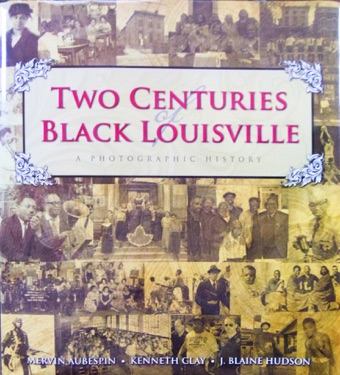
Many are seeing the implacable spread of an insoluble situation in urban core communities that have become high percentage poor and black.
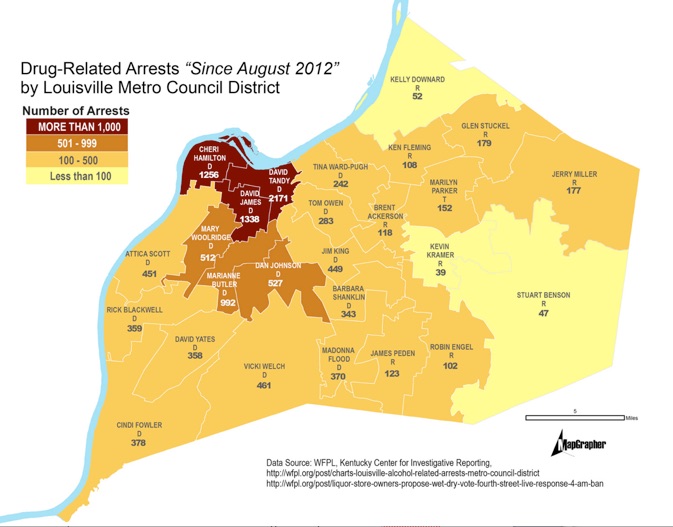
Map: Patrick Smith Urban Planner at City Reasearcher website:
Map: Patrick Smith Urban Planner at City Reasearcher website:
Map: Patrick Smith Urban Planner at City Reasearcher website:

This scene from Detroit in 2013 looks like an abandoned European city during the global armed conflict of World War II. Rebuilding the communities including the Jewish communities after World War II was understood to require an infusion of both democratic government stability and major economic re-investment to create jobs and revenue. Comprehensive programs to clean up the debris and rebuild functioning infrastructure were undertaken.
But in America, urban cores are being abandoned for decades to waste and left as ghettos for the black ‘under class.’
American racist oppression of slaves and their descendants and World War II Nazi racism and racist class exploitation of Jews and other ethnic groups are linked historically and have similar psycho-social dynamics.
Hitler mobilized the bigotry and xenophobia of the post World War I German right wing by targeting Jews as the cause of German poverty and thwarted national destiny. He found in the white working class a reservoir of frustration and xenophobic revulsion looking for an outlet. Using portrayals of Jews as bestial in media and manipulating the press he created a movement that was governmentally authorized to systematically exterminate the ‘others’ in the service of installing dominant white order and destiny.
The demographics of the Louisville apartheid show a similar dynamic has eroded black progress in Louisville for decades. Dominant white economic elites enjoy their social advantages in a country founded on rape and enslavement of blacks. While we progressed by degrees to disavow racist exploitation as a national instrument of our economic system, our disavowals did not amount to creation of a sufficient and comprehensive reconstruction of the splintered black community that was grudgingly set free. We had harmed them profoundly, but would not rebuild them.
Today, the questions appear in the form of major policy decisions made by the dominant white controlled economic development departments. Why would the economic and transportation groups in Metro Government commit the community to spend $ 2.4 billion for two new tolled highway bridges but leave the economic disparity and poverty in the West Louisville areas to fester?
“Almost always the injustices that dramatically diminish the rights of blacks are linked to the serious economic disadvantages suffered by many whites who lack money and power. Rather than acknowledge the similarity of their disadvanatage, particularly when compared to those better off, whites easily allow themselves to be persuaded that they must protect their sense of entitlement vis-avis blacks for all things of value. Evidently this racial-preference expectation is hypnotic. It is this compulsive fascination that seems to prevent most whites from even seeing --much less resenting--the far more sizeable gap between their status and that of those who occupy the lofty levels at the top of our society.”
Derrick Bell, Learning the Three ‘I”s of America’s Slave Heritage, from Slavery and the Law, Paul Finkleman, Ed.
Rowman & Littlefield Publishers 2002.
In the mass psychology of racism, the dominant social group services its followers by extending and maintaining a gap of privilege, both economic and social to maintain the mythology of superiority of one group of humans over another. A race class identification that even the impoverished white can boast. While not as overt and blatant as in the days of slavery or Jim Crow, the culture in Louisville remains comfortable that 12,000 school children shall be homeless here while $ 2.4 billion is spent building new suburban highways and bridges to reduce traffic congestion. In the same decision, the benefits of public transit modes such as light rail to address historic poverty and segregation were deemed less compelling public policy issues than improving cross river automobile travel.
The slave master used slaves as property and divided families
to satisfy his economic interests. The slave father lost his social position in the family in slavery. Today, high rates of arrest and incarceration and the institutional racism of present policy and geography are churning out black matriarchy single parent families at the same or higher rate.
After a long career of civil rights litigation and teaching at Harvard law school, Derrick Bell as part of the ‘critical race theory’ movement wrote: “Racism is an integral, permanent and indestructible component of this society.” The racist privilege is built in to our city urbanscapes and perpetuated by the failure of white dominant society to be stirred to action to correct the legacy of slavery rather than compound it. There is a war in slow motion happening in America’s urban cores creating devastation and refugees. It could be halted and reversed but that will require understanding the dynamics of the mass psychology of racism.
Bud Hixson
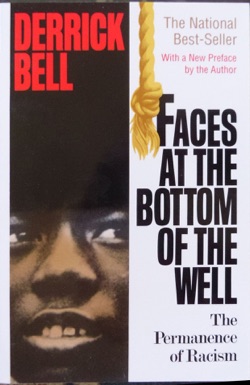
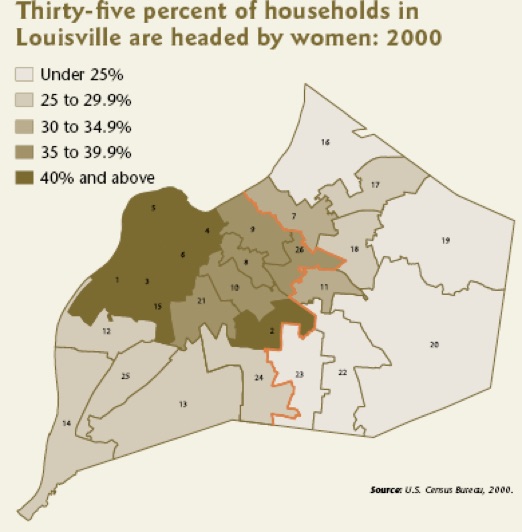

THE DIVIDING LINE Women and Housing Patterns in Louisville
Metropolitan Housing Coalition
We are also seeing an increase in single parent households, from 30% in 1990 to 41% in 2010. Additionally 50% of all children born in Louisville Metro
are now born to unmarried mothers.
The highest concentration of female households is 60 percent in Council
District 4, where the poverty rate is also the highest in the city at 47 percent. Female households are also densely clustered in other downtown
neighborhoods and in the far western and southwest areas of the city. These
areas of the city tend to have higher poverty rates and high concentrations
of Section 8 rental housing and other affordable options for low-income
families.
The rate of female households ranges from 20 percent of all households in Council District 16 to 60 percent in District 4
The contemporary social and economic factors in 2013 result in a 60% female head of household rate in District 4. In 1850 the rate in black Louisville communities was given as 37.7 %.

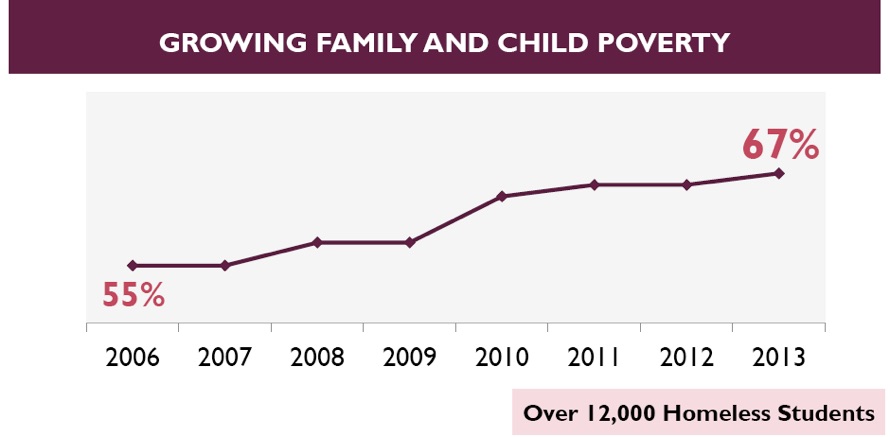
Jefferson County Public Schools Equity Scorecard HERE
The Impact of Slavery on Racial Inequality in Poverty
in the Contemporary U.S. South
Heather A. O’Connell, University of Wisconsin, Madison
Social Forces 90(3) 713–734, March 2012
Despite Civil Rights legislation, racial inequality persists, especially in the context of poverty. This study advances the literature on racial inequality and the Southern legacy of slavery by examining slavery’s relationship with inequality in poverty. I analyze county-level U.S. Census data using regression and spatial data analysis techniques. I find the 1860 slave concentration is related to contemporary black-white inequality in poverty, independent
of contemporary demographic and economic conditions, racialized wealth disparities and racial threat. My research suggests the importance of slavery for shaping existing U.S. racial inequality patterns. Insights derived from this research, including the formulation of legacy as a place-based, continuous phenomenon that is distinct from racial threat, provide the basis for future research on legacy’s mechanisms.
Finally, although not directly addressed by my analyses I articulate two potential pathways through which slavery might be linked to the contemporary period. First, slavery might be associated with contemporary black-white inequality because local areas previously dependent on slavery continue to be dependent on exploitative economic
systems. Future research should examine the historical trajectory of economic development in local areas, including contemporary economic structures, to assess the extent to which slavery was replaced with subsequent exploitative economic systems as suggested in previous historical work (Royce 1985; Shifflett 1982). Second, the
legacy of slavery may indirectly affect economic disparities through its influence on educational and political institutions. The distribution of resources across and within schools in local areas with high historical concentrations of slaves may be such that blacks receive a lower quality education than whites and are therefore less qualified in the labor market. In addition, differential access to political power could affect local
blacks’ control over other aspects of their lives, such as their ability to bargain with employers for higher wages and their voice in the distribution of local resources (see Duncan 1999). Regardless of the mechanism, my results suggest researchers and policy makers concerned with racial inequality in poverty within the South should focus on places with a higher historical concentration of slaves.
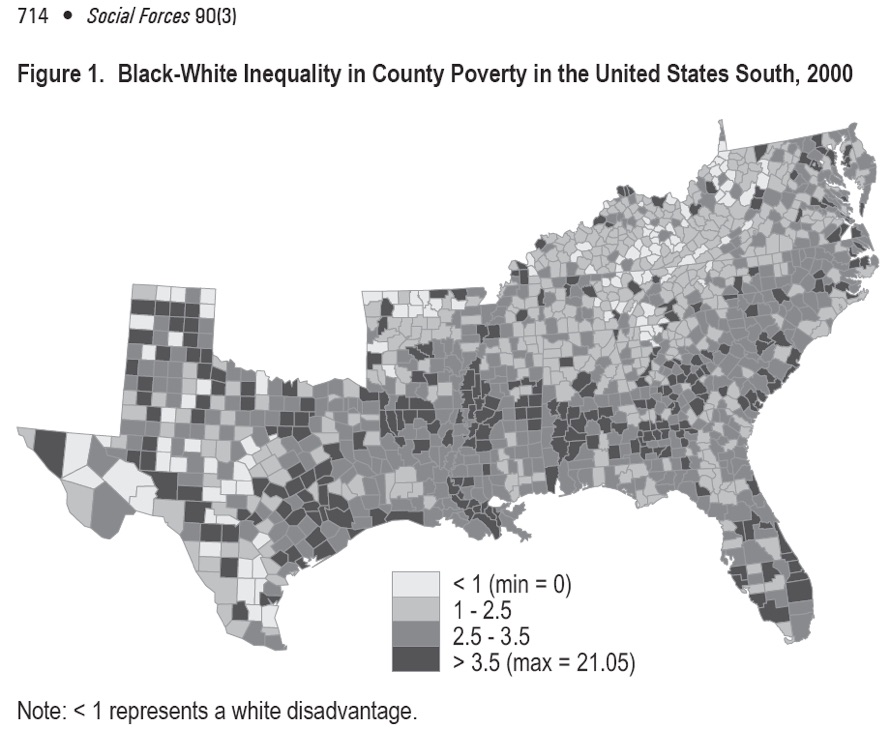
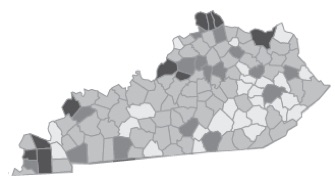
Louisville Metro
The Social/Ideological System leading to Fascism
rational individuals
with energy for change
innocent children
A Reichian Analysis of
after Wilhelm Reich’s Freudian analysis in The Mass Psychology of Fascism 3rd ed. published 1942
In the 1930s prior to the Nazi takeover of Germany, Wilhelm Reich worked with individuals in psychotherapy and developed a theory of ‘character analysis’ based on individuals experiences of social and parental childhood repression. His clinical experience led him to conclude guilt and shame over natural sexual attitudes led to self conflict and binding of anxiety in neurotic symptoms. Reich integrated his theories of individual repression into a ‘character of the masses’ to explain why the exploited German middle and working class chose Nazi fascism and genocide instead of socialism.
See Character Analysis HERE
See, for example–
Timothy Snyder --Housum Professor of History at Yale University, author of Black Earth: The Holocaust as History and Warning
17. Watch out for the paramilitaries.
When the men with guns who have always claimed to be against the system start wearing uniforms and marching around with torches and pictures of a Leader, the end is nigh. When the pro-Leader paramilitary and the official police and military intermingle, the game is over.
‘Let’s party like it’s 1933’: Inside the alt-right world of Richard Spencer
Nov 22 2016 John Woodrow Cox
“Let’s party like it’s 1933,” he declared, referencing the year Hitler was appointed Germany’s chancellor and the Nazis embarked on the creation of their own ethno-state.
http://www.npr.org/2016/08/26/491452721/the-history-of-the-alt-right
“Richard Spencer is the carefully crafted face of the alt-right. Last week, he organized a conference of white nationalists, who celebrated Donald Trump’s victory as their own. (Linda Davidson/The Washington Post)
Somewhere deep down, Spencer said, he has always had these beliefs. But the 2006 Duke lacrosse case, in which white members of the team were falsely accused of raping a black woman, made an impression, as did the writings of Jared Taylor, a white nationalist who lives in Northern Virginia.
Last week, he said that he would not date a nonwhite woman again and that he still wants interracial relationships barred.That belief is core to the alt-right’s most radical goal: an all-white country.
“We need an ethno-state,” he said in a 2013 speech, “so that our people can ‘come home again,’ can live amongst family and feel safe and secure.”
He ended his address by invoking the Rev. Martin Luther King Jr.: “I have a dream.”
Spencer, of course, would expel Muslims from his ethno-state. And most women, he said as he was being driven from the hotel to his next appointment, would return to their traditional role of bearing children.
“For us, as Europeans, it is only normal again when we are great again!” he shouted. “Hail Trump! Hail our people! Hail victory!”He raised his glass and, in video caught on camera by the Atlantic, the heart of the alt-right stood and cheered — and a number of them offered their leader the Nazi salute.”
December 9, 2016 by Bud Hixson
Donald Trump’s political victory demonstrates the powerful force of Christian patriarchal white middle class frustration. How far white frustration will carry a ‘strong man’ autocrat in America with its bedrock Constitutional system remains a question. Far enough to elect a President obviously–but far enough to victimize, imprison, strip of citizenship, non-white, leftist groups?
Trump’s managers understand that reactionary white racism is resident in a segment of the disaffected middle class.
The progress of the racial and gender diversity agenda under President Obama left broad masses fuming and angry. With Trump, the arguments over same sex marriages, early term abortions, and tolerance of Muslim customs seem ready to move on to legislation barring and condemning such progressive innovations.
White frustration can be inflamed and tapped as a powerful political tool–just as Hitler recognized in 1919-1933 it could be tapped to organize and build a ruthless Nazi party. Angry white men, frustrated in their local ambitions, displaced as family patriarchs, challenged by racial, religious and gender diversity, can be harnessed like mules to drag a violent agenda forward.
Most of the contemporary analysis comparing Trump’s politics and Hitler‘s fascist organizing have treated the subject superficially–focusing on personalities of the alt-right and particular features that resembled the way the Nazis deployed and seized power. But a more fundamental analysis is required to explain why, for at least the second time in history, the working white, middle class –men and women–voted into power a dangerous demagog who blamed the broad economic inequities of capitalism on immigrant populations living hand to mouth.
Wilhelm Reich, in his fascinating book, The Mass Psychology of Fascism attempted a systematic dissection of the Nazi rise to power. Reich was a practicing Freudian psychoanalyst in Vienna and Berlin in the 1920s and originated an active method of analysis of character ‘resistance.‘ See, George Makari, pp 391-404, Revolution in Mind. Reich ran a psychoanalytic clinic and was familiar first hand with the inner mind of the frustrated Caucasian.
What contemporary critics omit, that Reich understood, from his clinical work, was the linkage between sex, religion, patriarchal oppression and the deep frustration of the white middle class male compounded by failing economic systems. Why, Reich asked, in his first chapter, Ideology as a Material Force, why “at the crossroads between socialism and barbarianism, it was in the direction of barbarianism that society had proceeded. For the international strengthening of fascism and the lagging behind of the worker’s movement was nothing other than that. “
The choice before the American electorate in 2016 resembled that before German society in 1919-1933. The Americans’ like the Germans, chose the brash, macho candidate who conjured a mystical ‘greatness’ over one who painstakingly detailed pragmatic programs. The brutal ignorance of the middle class tangled up in its social and sexual repressive family structure seeks mystical release in Christian mythology and Aryan purity notions. Authoritarian fascism reasserts the supremacy of the father in the family as a mirror for the warrior national leader who sees immigrant threats to the family and country. Anyway, the romance of militarism sells real well to the masses of testosterone-choked young males.
What the male tyrant offers is to make the poor white male the ‘king’ in his home, the leader in his community, and the heroic adventurer as he crushes the enemy. Reich believed the ‘little man’ in his anger and frustration seeks in misogynistic violence the orgastic release he can’t achieve in real relations. Because the dissatisfaction of the angry white American male is fully as deep and deluded as his German counterpart, its quite possible that as virulent a fascism could arise here in America --if other conditions– like a widespread economic collapse appear.
Trump is not yet– and may never be– the kind
of megalomaniacal Fuhrer that Hitler became.
That transition– from being jailed to leading the
world into global war –depended on lots
of circumstances that were particular to Germany
in the period 1919 -1933.
But, between 1918, the end of the First World War and 1933 –for a period of 15 years, Nazi fascism overthrew the democratic government in Weimar Germany. What cannot be overlooked or understated is that the middle class eagerly embraced the call to armed conflict. Fascism originates in the masses.
That Nazi project began by blaming 'impure races' and suspect political parties – Jews, Communists, Gypsies –for global and local economic malaise during the Great Depression. Then, groups of organized thugs appeared to root out the enemy and damage and burn their property.
National economic conditions, especially as it pertains to the economic wellbeing of the white middle class, played a major role in powering the Nazi rise during the Great Depression. America's national economy may now be poised to provide widespread economic malaise. See for example,
"[In 2016] The average indebted household’s balance rose to $7,817 in the second quarter, just $611 below a level that WalletHub has identified as being unsustainable. Add to that the relative ease of obtaining credit and the snapshot looks quite similar to the situation in the United States in the second quarter of 2007, just six months ahead of the beginning of the Great Recession."
http://247wallst.com/economy/2016/09/12/us-credit-card-debt-to-top-1-trillion-in-2016/
Other social observers have described the potential for the development of an American fascism. Given the propensity of the citizenry, it could unfold stepwise:
https://fcit.usf.edu/holocaust/timeline/nazifica.htm
1) Promulgation of basic ideology that engages the white male as patriarch in the home, who dominates the female and has entitlement to occupy and control the country, its national policy and to exclude immigrants, non-Christians and non-whites.
2) White middle class unrest due to economic stress, rising debt, low income, high unemployment, joined with perceived threat to patriarchal authoritarian social values by gays, feminists, atheists and Muslims.
3) Formation of a centralized right wing party structure and bureaucracy elevating the iconic image of the strong man who is to be given exceptional authority and discretion due to his ‘vision’ of heroic personal sacrifice to Make America Great.
3) Formation of a brutal vanguard of ideological enforcement thugs –bullies who perpetrate violent disruption of the left wing diversity threats. From just 27,000 members in 1925, the Nazi Party grew to 108,000 in 1929.
4) General economic collapse and spread of poverty and unemployment among the white middle class. 1932 Great Depression.
5) A terrorist incident that authorizes rule by emergency decree. In 1933, the burning of the German legislature, Reichstag blamed on Communists authorized the Nazi police state. In 2017, an Islamic attack on American soil raises the spectre of emergency police action that breaches civil rights.
6) By 1932 The SA brownshirts, about 400,000 strong, were a part of daily street violence. American political institutions will be pretty much demolished by the time we see anything comparable to Brownshirts.
7) 1933 Within months of Hitler's appointment as Chancellor, the Dachau concentration camp was created. The Nazis began arresting Communists, Socialists, and labor leaders.
8) Hitler announced the Nuremberg Laws in 1935. These laws stripped Jews of their civil rights as German citizens and separated them from Germans legally, socially, and politically.
The failure of Hillary Clinton in the 2016 presidential election sent a sharp pang of concern through a majority of voters. The major media had failed to alert the public that Donald Trump’s appeal to mystical family-religious traditional values– in a time of economic dislocation– was fusing a connection that would topple progressive policies.
Though a lot of discussion and analysis has been in the popular press and the words, “fascism” and “Hitler” are more often seen, very few opinion writers carry back the analysis to the deep seated psychological roots that periodically unleash mass murder.
Fascism and the election of dictators that kill millions of victims is a function of what Reich called, “the emotional plague.” Given the choice between rational economic planning and social justice and equality, the unhappy white male would rather gamble on the prospect of world domination. In our times, many powerful forces are gathered behind perilously balanced international political stances. The examples of World War II and its consequences have not been lost on many. If Donald Trump harbors an irrational political agenda, including trashing American democracy, the world will know it soon enough.
See, Wilhelm Reich, Listen, Little Man!,
illustrations by William Steig, 1948
Fascism begins at home
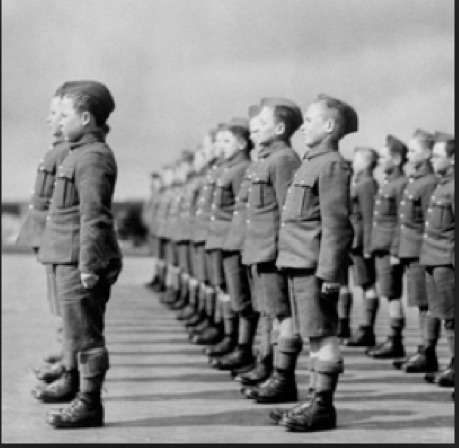
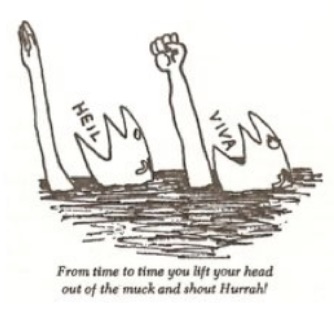


family socialization
neighborhood socialization
patriarchal authoritarian
repressive
indoctrination
life affirming attitudes
building self reliance
rational scientific
reactionary conservatism inflexible and frustrated
“angry middle class
that wants change”
alienation/rejection of dominant ideology after internalization
corporate church-state ideological complex church law and morality theories
church and mosque moral law and instruction
ideological / mystical educational system
grade-middle school
educational theories
adapted to dominant ideology
workplace preparation
acceptance/ internalization of dominant class moral law and
social ideology












Reich believed human beings start out capable of giving and receiving affection but subsequent socialization including violent and perverse repression and sexual violence and exploitation in childhood produce a range of beliefs, attitudes and inhibitions, including chronic muscular ‘armour’ conditions that prevent natural emotional function and expression unless worked through in analysis.
People not crippled by repression are capable of expression and self affirmation
The ancient religions had become engines of repression using the psychological effect of sex-negation and moral codes to create ideological control over their adherents. Church authorities established dominion by violently enforced moral codes that controlled personal relationships. The church used male parental authority in the patriarchal family unit to indoctrinate children into the same codes and mystical ideologies.
To the extent the school system incorporated the moral ideology of repression it became another organ for repressive indoctrination.
For some, chaos and anarchy were
preferable to obedience to the
repressive social order–
This Political Theorist Predicted the Rise of Trumpism. His Name Was Hunter S. Thompson.

proto - fascists denying their contradictions and looking for a scapegoat to blame for their misery
rebellion into criminal subculture expansion of
criminal sub culture in power and influence
obedience to dominant ideology masses available for exploitation of their labor by capital elite
billionaires
homeless
wretched economic condition of the masses




masses incapable
of political organization for rational economic change


This was the payoff for the King, the Pope, the Mullah, the Fuhrer- a people who had been filled with internal contradictory impulses and rendered confused and obedient to authority. Internally they were unhappy and unfulfilled unable to naturally express and receive love. Specifically
in Germany they chose reactionary
Nazi ideology over economic self
interest and followed authoritarian
ideology into genocide.
Given that the ‘character structure’ of the masses had been reduced to dependence on moral authority and self negation, the authoritarian social ideology could be imposed on them without rebellion as they closed their eyes to their own condition and lived through the glorification of the Fuhrer.
The indoctrination didn’t take completely with some (it never does) and they created their own unauthorized sub-culture of crime and immorality. This was not the natural free society that un-repressed people would build, but an angry retaliatory abusive culture based in part on violent exploitation and enforcement.
In a global community where religion is widely established and fully integrated into the character structure of the masses, the dynamics of social political decision making depend in part on the extent families are allowed to raise children without vicious repression and negation imposed by authoritarian ideology.
The combination of repressive early childhood training that produced emotionally crippled adults and exploitive social ideology produces reactionary conservative masses. In Reich’s analysis these unfulfilled adults could be infused with mystical ideology and their inner frustration turned against an enemy, such as the Jewish population in the genocide of WWII. Reich’s theories describe the conversion of natural aggression into perverse sadism by forcing natural affection into the repressed unconscious.

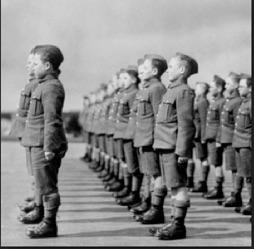
facist state ideology coupled with militarism
WAR-GENOCIDE
Death of millions
